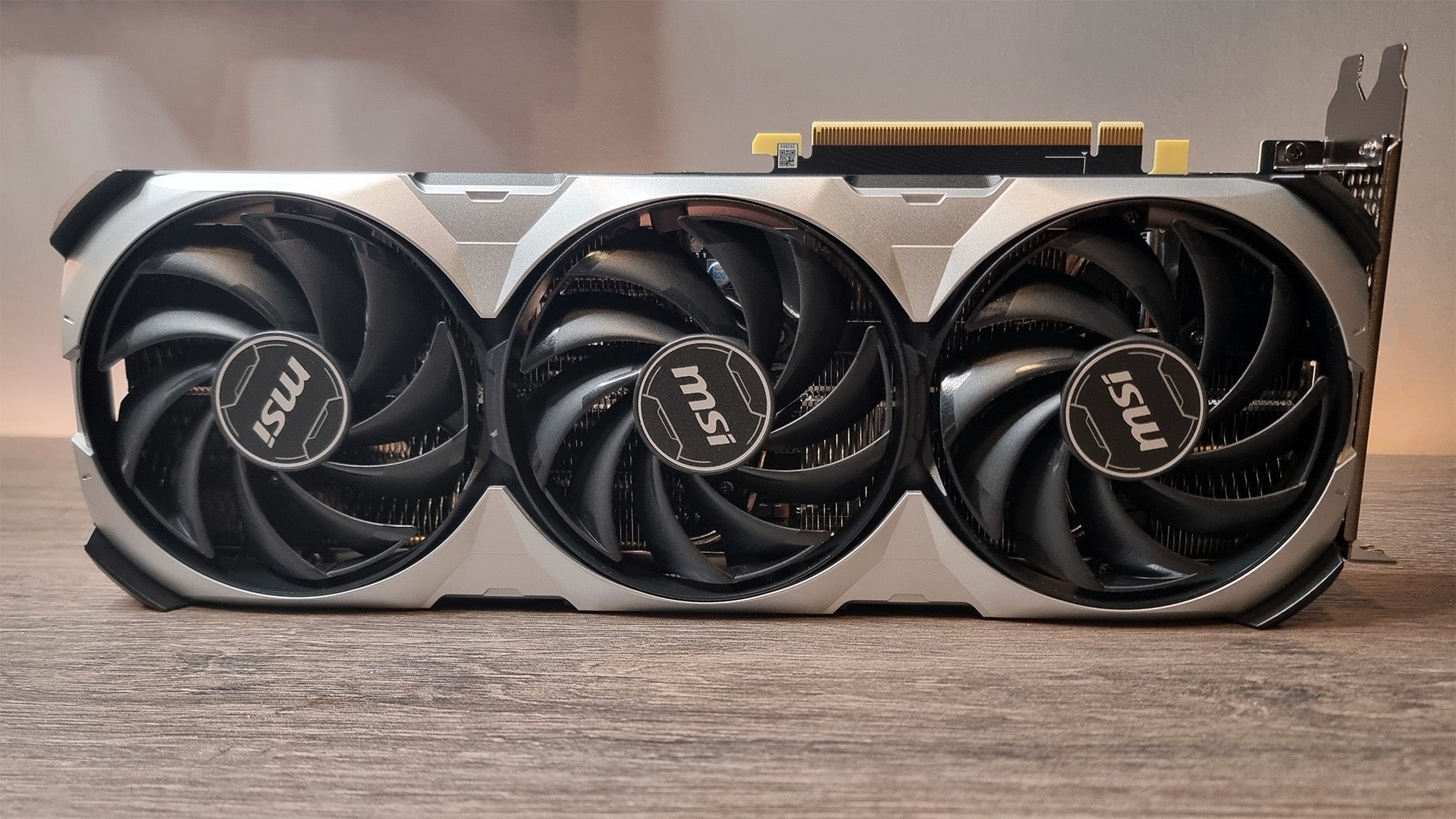Nvidia GeForce RTX 3050 Review
A new budget graphics card with ray tracing support
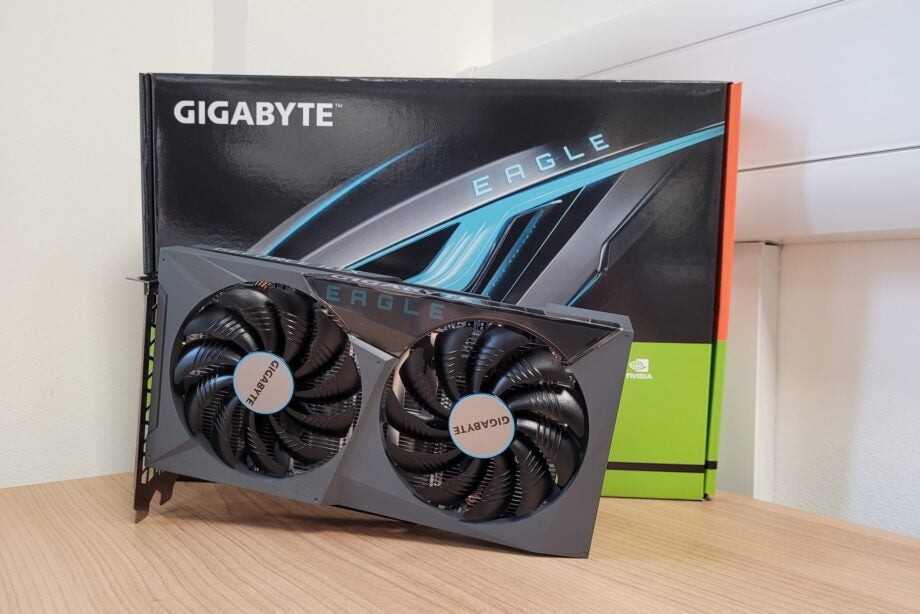
Verdict
The Nvidia RTX 3050 is one of the cheapest graphics card available in Nvidia’s latest range, yet it still manages to hit a 1080p at 60fps performance for most games while also offering high-end features such as ray tracing and DLSS. But with a performance not too dissimilar to the 3-year old GTX 1660 Ti, those who like high frame rates will want to look elsewhere.
Pros
- Solid 1080p performance
- Ray tracing and DLSS at a budget price
- Low power consumption
- HDMI 2.1 support
Cons
- Offers similar performance to GTX 1660 Ti
- Reliant on DLSS to hit high frame rates
- Will likely be hard to find in stock at RRP
Availability
- UKRRP: £239
- EuropeRRP: €279
Key Features
- 1080p performance:Is capable of hitting 60fps with most games when playing in 1080p.
- Supports DLSSDLSS uses upscaling technology to boost a supported game’s frame rate without a big decline to image quality.
- Supports ray tracing:Ray tracing allows supported games to feature advanced lighting and shadow effects.
Introduction
It’s easy to get caught up in the hype for all of the most powerful graphics cards – like the upcoming RTX 3090 Ti – but it’s usually the budget options that are the most popular, and the Nvidia RTX 3050 is exactly that.
This new RTX 3050 graphics card has a clear focus: 1080p gaming with support for ray tracing where possible. It is technically capable of hitting higher Quad HD and 4K pixel counts, but only at a great cost to the frame rate.
The Nvidia RTX 3050 may be the cheapest graphics card in the 30-Series range at the time of writing, but since it packs the Ampere architecture and is capable of high-end features such as DLSS and ray tracing, it’s nothing to be sniffed at.
So does the RTX 3050 merit the accolade of a ‘bargain buy’ or has Nvidia dumbed down the specs enough to lose that Ampere magic? Here are my thoughts after testing out the Gigabyte’s RTX 3050 Eagle OC 8G.
And if you want to check out direct comparisons with other budget cards, check out our Nvidia RTX 3050 vs RTX 3060 Ti and Nvidia RTX 3050 vs Nvidia GTX 1660 Ti articles.
Specs and design
- Features Nvidia’s latest Ampere architecture
- Supports both ray tracing and DLSS
- Packs the least powerful specs in the Ampere range
The Nvidia RTX 3050 is built on 30-Series Ampere architecture, which is the latest available from Team Green. That means it’s bragging 2nd gen RT Cores and 3rd gen Tensor Cores, making the GPU more efficient than the previous generation when taking on the likes of DLSS and ray tracing.
As a result, this is one of the cheapest graphics cards you can buy that’s capable of ray tracing, which is arguably its main appeal, especially when compared to the likes of the GTX 1660 Ti.
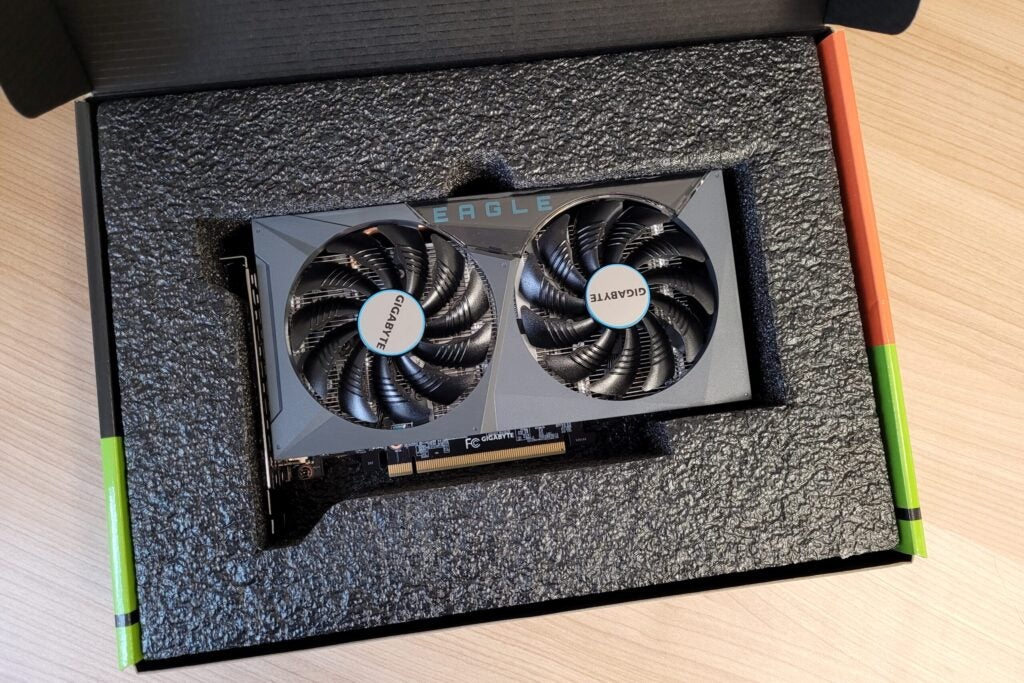
But what exactly is ray tracing? This is an advanced rendering technique that can help to produce more realistic lighting and shadow effects. It’s particularly renowned for its excellent reflections, helping to create more photo-realistic environments. Ray tracing is only supported by a select number of games, but it really helps to improve the visuals for the likes of Control, Cyberpunk 2077 and the upcoming Dying Light 2.
DLSS (deep learning super sampling), meanwhile, is a spatial image upscaling technology that uses artificial intelligence to give the frame rate performance a significant boost without any major compromises to the visual quality. On paper, it’s particularly important for cards like the RTX 3050, allowing for a smoother performance despite the GPU’s limited power.
Outside of Nvidia’s high-end features, the RTX 3050’s specs look quite ordinary. It packs just 2560 CUDA Cores – for comparison, the RTX 3060 features 3584 CUDA Cores, and the RTX 3060 Ti flaunts 4864. This makes the RTX 3050 the weakest of the trio by quite a margin.
| Architecture | CUDA Cores | Boost clock speed (GHz) | Memory | Graphics card power (W) | |
| Nvidia RTX 3050 | Ampere | 2560 | 1.78 | 8GB GDDR6 | 130 |
| Nvidia RTX 3060 | Ampere | 3584 | 1.78 | 12GB GDDR6 | 170 |
| Nvidia RTX 3060 Ti | Ampere | 4864 | 1.67 | 8GB GDDR6 | 200 |
| Nvidia GTX 1660 Ti | Turing | 1536 | 1.77 | 6GB GDDR6 | 120 |
The Nvidia RTX 3050 at least features the same 8GB GDDR6 memory as the RTX 3060 Ti, but it’s worth noting that it also lags far behind in terms of Memory Interface Width.
It’s not great readings for the RTX 3050, but this was never supposed to be an all-new powerful card – it’s instead Nvidia’s attempt at scaling down the specs as far as possible to make the card more affordable, while still offering a competent 1080p performance.
The RTX 3050 does have one positive over its more powerful siblings though, as it requires less power with just a 130W power consumption. So if you want to play in Full HD, but also don’t fancy seeing your electricity bill spiral out of control, this may well be a good pick.
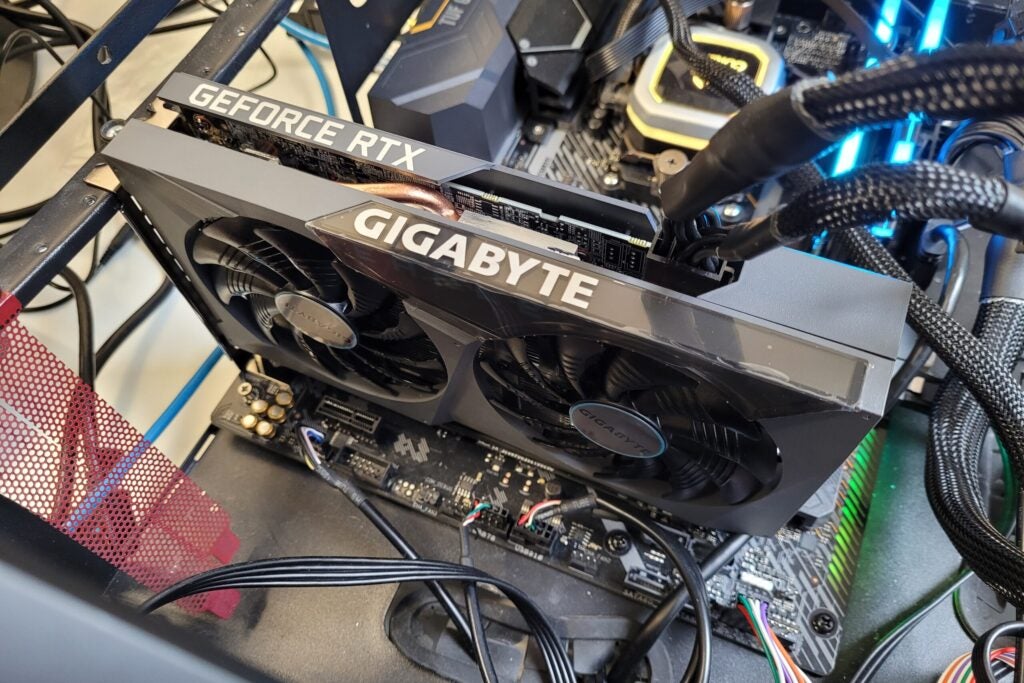
Since Nvidia isn’t selling a Founder’s Edition of the RTX 3050, you’re going to have to buy the GPU from a third-party manufacturer. For this review, we’re testing Gigabyte’s RTX 3050 Eagle 8GB graphics card. It has a compact dual-fan design, which looks tiny compared to Nvidia’s Founder’s Edition RTX 3060 Ti.
Of course, the RTX 3050 will come in all shapes and sizes with all of the different third-party manufacturers, which could potentially see minor differences in performance. But they all have the same RTX 3050 GPU chip inside, so the fluctuations shouldn’t be too noticeable.
Interestingly, there’s no need for an adaptor for the PCIe connection with the RTX 3050, unlike the rest of its 30-Series siblings. You’re still getting Ampere-flavoured benefits here though, such as an HDMI 2.1 connection, ensuring the GPU is compatible with 8K TVs – the RTX 3050 won’t be able to hit those resolution heights, but it’s still good to have.
Benchmarks
- Capable of a 1080p at 60fps performance for most games
- Similar performance to a GTX 1660 Ti
- Struggles with ray tracing without DLSS
Just because a graphics card is cheap, it doesn’t necessarily mean it’s good, as it needs to hit the performance sweet spot to ensure it’s capable of playing modern games at respectable frame rates. As such, we ran the Nvidia RTX 3050 graphics card through various games to see how it fares.
We tested the RTX 3050 with both synthetic and in-game benchmarks to evaluate its performance, while also checking out the idle and peak power draws. We tested every game with the highest preset available at three resolutions: 1080p, 1440p and 2160p.
We also tested three other graphics cards to compare the results, which included the GTX 1660 Ti, RTX 3060 Ti and AMD Radeon RX 6600 XT. We’d have liked to include the RTX 3060 and AMD Radeon RX 6500 XT in the benchmarks too, but don’t currently have access to them.
To ensure fair testing, every graphics card was used in the exact same PC. Check out our rig’s tech specs below:
Test rig specs:
- OS: Windows 11
- Motherboard: TUF Gaming X570-Plus (Wi-Fi)
- Processor: AMD Ryzen 7 5800X
- Memory: 16GB DDR4 RAM
- PSU: Corsair HX850
- Cooler: Corsair Hydro Series H150i PRO RGB
With that out of the way, let’s check out all of the benchmark results:
Control
| Resolution | Ray tracing off / DLSS off | Ray tracing on / DLSS off | Ray tracing on / DLSS on |
|---|---|---|---|
| 1920 x 1080 | 55fps | 33fps | 55fps |
| 2560 x 1440 | 35fps | 22fps | 38fps |
I chose Control to test out both the DLSS and ray tracing performance on the Nvidia RTX 3050, as it’s a relatively modern game that uses both RTX features to great effect.
As expected, having ray tracing activated saw the 1080p performance drop down from 55fps to 33fps, which is a fairly big issue for a card that’s being championed as the most cost-effective option for the light-rendering technology.
Fortunately, DLSS was successful in offsetting that performance drop, bringing it back up to 55fps. Nvidia’s done some fantastic work with DLSS over the years, as the image quality is virtually identical to the original picture, despite upscaling the image.
It’s also worth pointing out that by activating DLSS, I was able to run Control in 4K at a reasonable 30fps performance. That may not hit the ideal 60fps mark for PC gaming, but it’s still far better than the original unplayable 16fps performance that I saw with DLSS deactivated.
The Nvidia RTX 3050 is a great example to prove just how important ray tracing and DLSS can be – without them, this new GPU isn’t much better than a GTX 1660 Ti. That said, DLSS and ray tracing are only available with select games, so it’s worth checking beforehand whether your favourite titles are supported.
Horizon Zero Dawn
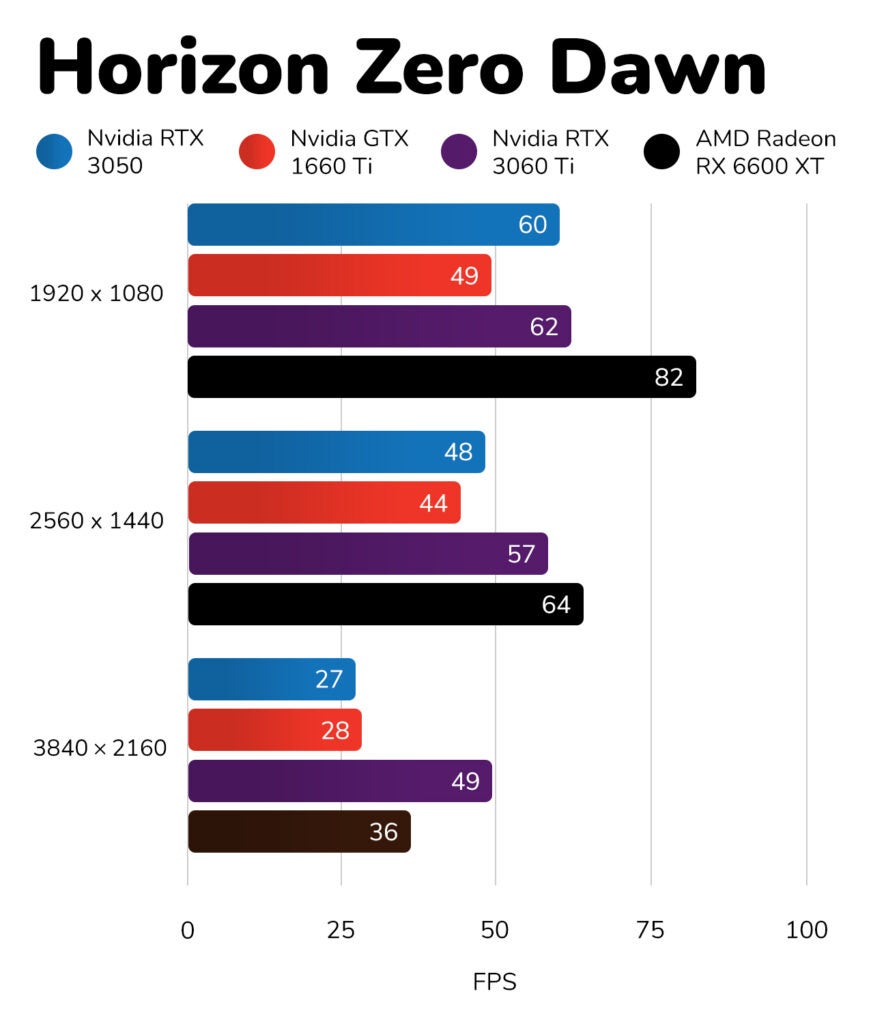
I also chose to use Horizon Zero Dawn in our tests, since it’s a modern open-world game that really challenges your PC’s performance. The RTX 3050 performed very well here, hitting the target 60fps performance at a 1080p resolution, which is close to the results of the RTX 3060 Ti.
Those performance scores take a nosedive once you take the resolution up to 1440p and 4K, falling to 48fps and 27fps respectively. This hammers home the point that RTX 3050 is a graphics card for Full HD gaming. If you’re craving additional pixels, you’re better off spending more on the likes of the RTX 3060 Ti.
Borderlands 3
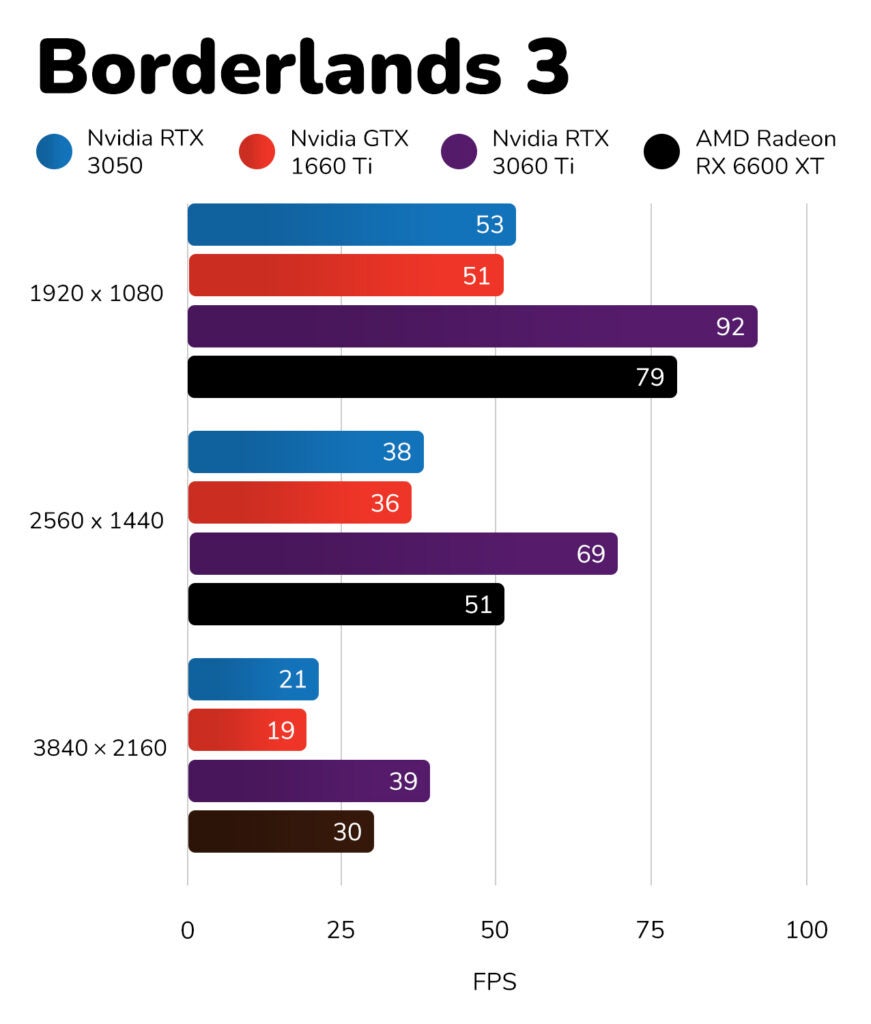
Borderlands 3 is another challenging game for your GPU, representing my first-person shooter in the testing process. The RTX 3050 disappointingly failed to fit the 60fps mark here, achieving 52.8fps. That’s still very much playable, mind, it’s just not as smooth as you’d want for a card that specialises in 1080p gaming.
Crank the resolution up to 4K, and you’ll see the performance fall to 20.73, which is virtually unplayable. But again, this is not a card designed for an Ultra HD performance so it would be unfair to deduct points for that.
What is a little worrying is that RTX 3050 offers almost identical performance to Nvidia’s GTX 1660 Ti, which launched back in 2019. This reinforces the point that the RTX 3050 is basically just a GTX 1660 Ti GPU with the added capability of ray tracing and DLSS. To be fair to Nvidia, it has priced the GPU accordingly at £239/€279.
Dirt Rally
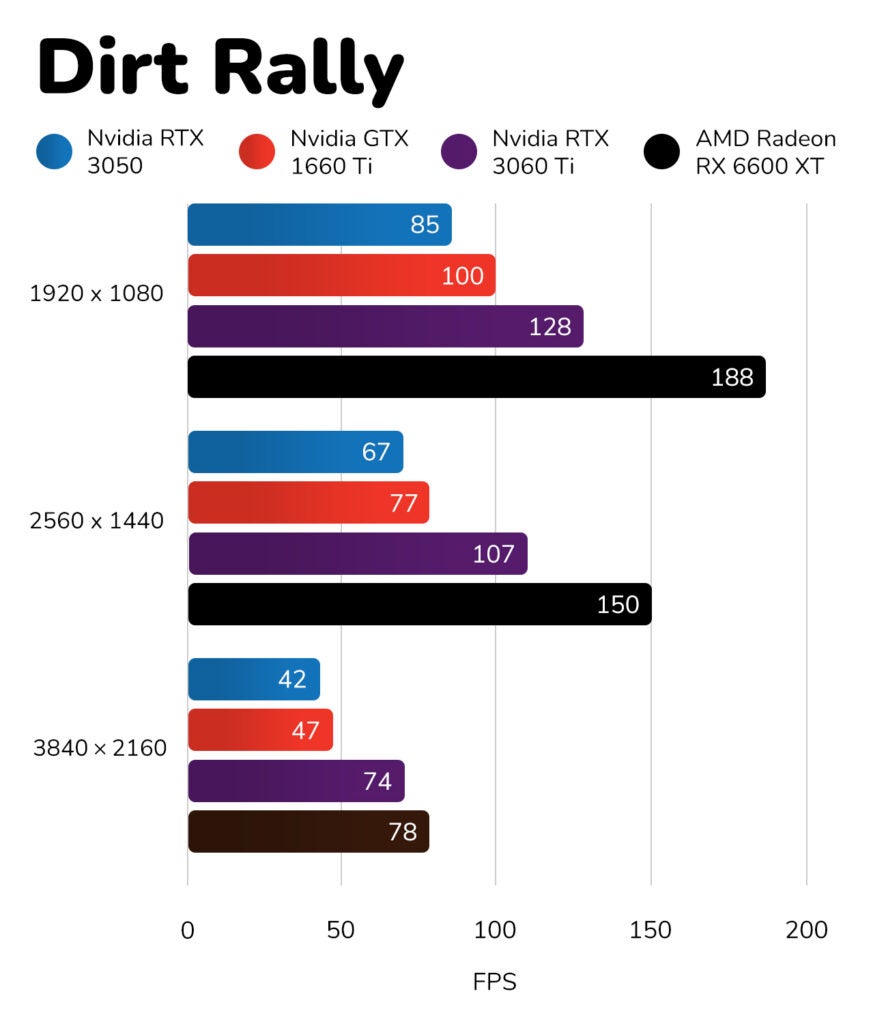
To round off the gaming tests, I picked Dirt Rally as an example of an old game (released in 2015) to show how the GPU deals with less demanding titles such as eSports. Ideally, you want these results to be as high as possible to see whether the RTX 3050 can make the most out of your monitor’s high refresh rate.
The RTX 3050 saw a 85fps performance in 1080p, and a 42fps result in 4K. Those results are pretty unremarkable, with even the GTX 1660 Ti faring better. Jump up to the RTX 3060 Ti, and that Full HD result will climb up to a whopping 128fps, while the 4K performance leaps to 74fps.
As such, the RTX 3050 is really not an ideal GPU for eSports gaming. If you care about high refresh rates that far exceed 60fps, then you’ll be disappointed here. This graphics card is clearly intended for those who want to hit 1080p while spending as little money as possible.
3DMark Time Spy Extreme
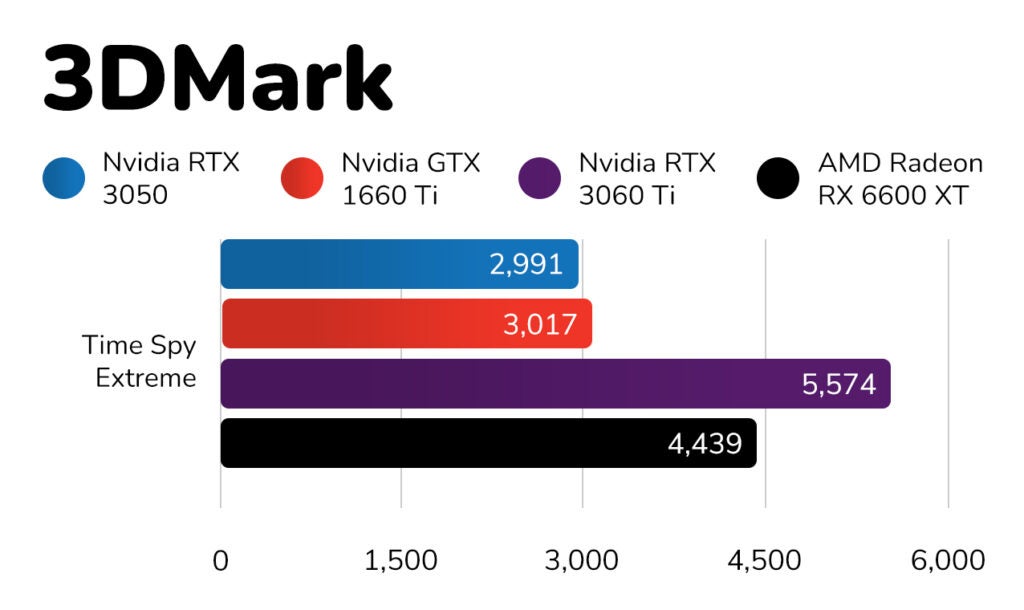
3DMark’s Time Spy Extreme is a synthetic benchmark that tests the raw performance of a graphics card. It won’t give you an estimate of what kind of performance you should expect from each game, but spits out a numeric score after evaluating the GPU’s overall performance.
With our testing, the RTX 3050 saw a score of 2991. That’s admittedly not great, with the older Nvidia GTX 1660 Ti seeing a 3017 result in comparison. That said, there really isn’t much difference between those scores, which is reflected by the game benchmark results.
3DMark Time Spy Extreme also fails to consider features such as DLSS and ray tracing, which make the RTX 3050 a more attractive option.
Power consumption and heat
- Low peak power consumption compared to other GPUs
- Idle power consumption isn’t as low as AMD’s card
Performance isn’t the only factor worth considering when it comes to graphics cards, especially if you don’t want your electricity bills getting even more expensive. Fortunately, the RTX 3050 has a relatively low graphics card power at just 130W. For comparison, the RTX 3060 and RTX 3060 Ti have graphics card power figures of 170W and 200W.
| Idle power consumption | Peak power consumption | Peak temperature | |
|---|---|---|---|
| Nvidia RTX 3050 | 61W | 225W | 67°C |
| Nvidia GTX 1660 Ti | 58W | 213W | 65°C |
| Nvidia RTX 3060 Ti | 60W | 317W | 69°C |
| AMD Radeon RX 6600 XT | 46W | 272W | 66°C |
We put these figures to the test by seeing the peak power draw when running the high-intensive 3DMark Time Spy Extreme benchmark. With the RTX 3050 inside the rig, the PC saw a peak power consumption of 213W – the RTX 3060 Ti card saw a peak of 317W, which means it’s significantly more power thirsty.
But the RTX 3050 wasn’t as impressive for its idle performance, which judges the performance when the computer isn’t running any intensive tasks such as a video game. AMD’s Radeon RX 6600 XT was the clear winner in this test, despite having a noticeably more powerful performance.
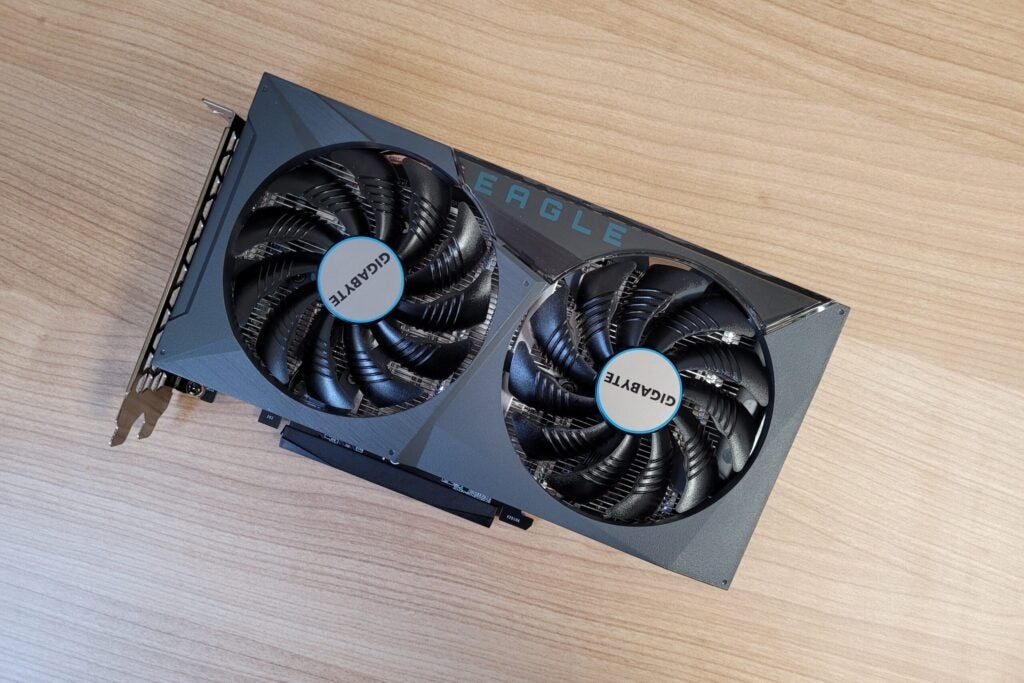
In terms of thermal performance, the RTX 3050 saw an even higher peak temperature than the RTX 3060 Ti, but admittedly only by a couple of degrees.
After running 3DMark, the peak temperature came in at 67°C. That’s a similar result to all of the other cards on test, so you shouldn’t need to worry about this GPU overheating.
Should you buy it?
If you want a budget ray tracing GPU:
The Nvidia RTX 3050 offers a similar performance to the GTX 1660 Ti, which may be disappointing to some, but the added bonus of DLSS and ray tracing makes this card more appealing, especially considering its budget price.
If you care about high frame rates:
If you’re playing games without DLSS activated, you’re likely going to struggle to reach a high frame rate which could be a turn off for those who own a 144Hz monitor. Even 2015’s Dirt Rally failed to pass the 90fps mark.
Final Thoughts
The Nvidia RTX 3050 is a solid graphics card for 1080p gaming, hitting 60fps for the majority of AAA games. However, it offers a similar performance to the GTX 1660 Ti despite that GPU launching three years ago and using older architecture.
The RTX 3050’s greatest strength is its support for the likes of ray tracing and DLSS, despite its budget price. This makes a big difference to both the visual quality and performance of a game, but such features are only supported by select titles. As a result, you really need to make sure your favourite games are supported by the RTX featureset before making the leap to the RTX 3050.
How we test
Every graphics card we review is run through a series of synthetic and real world benchmarks to gauge its performance, power efficiency and potential for overclocking.
Tested with in-game benchmarks
Power consumption checked
Compared against other cards we’ve tested
FAQs
The RTX 3050 has been purpose built for gaming, and can hit a 1080p at 60fps performance for the majority of AAA games.
This is the cheapest graphics card currently available in Nvidia’s latest range.
Ray tracing is an advanced rendering technology that makes lighting effects and shadows look more realistic.






